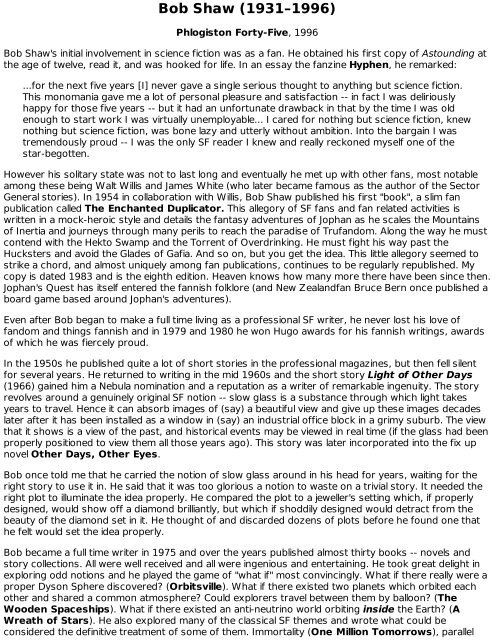Triffids Beard 2 - The Bearded Triffid
Triffids Beard 2 - The Bearded Triffid
Triffids Beard 2 - The Bearded Triffid
Create successful ePaper yourself
Turn your PDF publications into a flip-book with our unique Google optimized e-Paper software.
Bob Shaw (1931–1996)<br />
Phlogiston Forty-Five, 1996<br />
Bob Shaw's initial involvement in science fiction was as a fan. He obtained his first copy of Astounding at<br />
the age of twelve, read it, and was hooked for life. In an essay the fanzine Hyphen, he remarked:<br />
...for the next five years [I] never gave a single serious thought to anything but science fiction.<br />
This monomania gave me a lot of personal pleasure and satisfaction -- in fact I was deliriously<br />
happy for those five years -- but it had an unfortunate drawback in that by the time I was old<br />
enough to start work I was virtually unemployable... I cared for nothing but science fiction, knew<br />
nothing but science fiction, was bone lazy and utterly without ambition. Into the bargain I was<br />
tremendously proud -- I was the only SF reader I knew and really reckoned myself one of the<br />
star-begotten.<br />
However his solitary state was not to last long and eventually he met up with other fans, most notable<br />
among these being Walt Willis and James White (who later became famous as the author of the Sector<br />
General stories). In 1954 in collaboration with Willis, Bob Shaw published his first "book", a slim fan<br />
publication called <strong>The</strong> Enchanted Duplicator. This allegory of SF fans and fan related activities is<br />
written in a mock-heroic style and details the fantasy adventures of Jophan as he scales the Mountains<br />
of Inertia and journeys through many perils to reach the paradise of Trufandom. Along the way he must<br />
contend with the Hekto Swamp and the Torrent of Overdrinking. He must fight his way past the<br />
Hucksters and avoid the Glades of Gafia. And so on, but you get the idea. This little allegory seemed to<br />
strike a chord, and almost uniquely among fan publications, continues to be regularly republished. My<br />
copy is dated 1983 and is the eighth edition. Heaven knows how many more there have been since then.<br />
Jophan's Quest has itself entered the fannish folklore (and New Zealandfan Bruce Bern once published a<br />
board game based around Jophan's adventures).<br />
Even after Bob began to make a full time living as a professional SF writer, he never lost his love of<br />
fandom and things fannish and in 1979 and 1980 he won Hugo awards for his fannish writings, awards<br />
of which he was fiercely proud.<br />
In the 1950s he published quite a lot of short stories in the professional magazines, but then fell silent<br />
for several years. He returned to writing in the mid 1960s and the short story Light of Other Days<br />
(1966) gained him a Nebula nomination and a reputation as a writer of remarkable ingenuity. <strong>The</strong> story<br />
revolves around a genuinely original SF notion -- slow glass is a substance through which light takes<br />
years to travel. Hence it can absorb images of (say) a beautiful view and give up these images decades<br />
later after it has been installed as a window in (say) an industrial office block in a grimy suburb. <strong>The</strong> view<br />
that it shows is a view of the past, and historical events may be viewed in real time (if the glass had been<br />
properly positioned to view them all those years ago). This story was later incorporated into the fix up<br />
novel Other Days, Other Eyes.<br />
Bob once told me that he carried the notion of slow glass around in his head for years, waiting for the<br />
right story to use it in. He said that it was too glorious a notion to waste on a trivial story. It needed the<br />
right plot to illuminate the idea properly. He compared the plot to a jeweller's setting which, if properly<br />
designed, would show off a diamond brilliantly, but which if shoddily designed would detract from the<br />
beauty of the diamond set in it. He thought of and discarded dozens of plots before he found one that<br />
he felt would set the idea properly.<br />
Bob became a full time writer in 1975 and over the years published almost thirty books -- novels and<br />
story collections. All were well received and all were ingenious and entertaining. He took great delight in<br />
exploring odd notions and he played the game of "what if" most convincingly. What if there really were a<br />
proper Dyson Sphere discovered? (Orbitsville). What if there existed two planets which orbited each<br />
other and shared a common atmosphere? Could explorers travel between them by balloon? (<strong>The</strong><br />
Wooden Spaceships). What if there existed an anti-neutrino world orbiting inside the Earth? (A<br />
Wreath of Stars). He also explored many of the classical SF themes and wrote what could be<br />
considered the definitive treatment of some of them. Immortality (One Million Tomorrows), parallel


